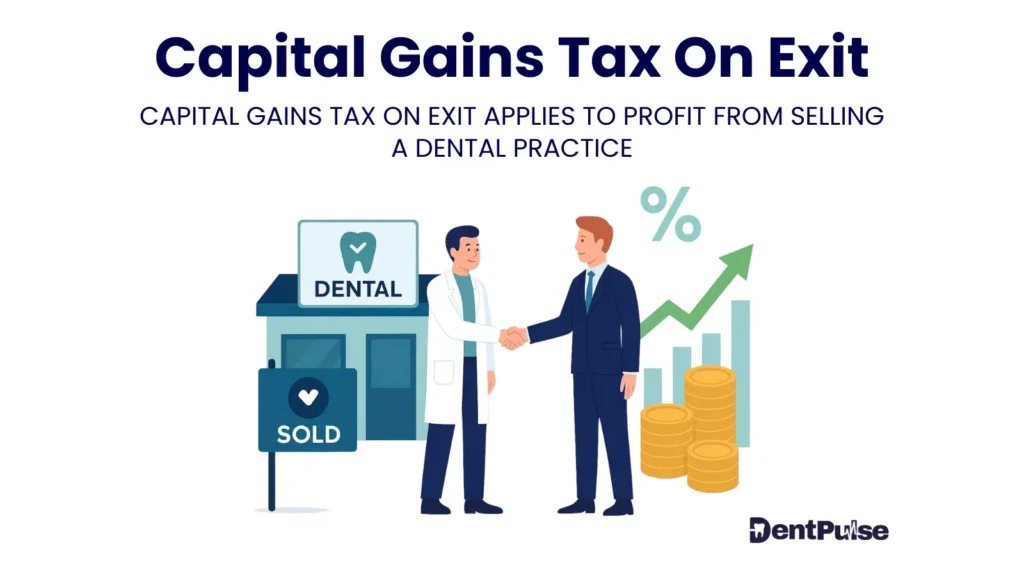What Is Capital Gains Tax (CGT) on Exit for Dental Practice Owners?
Capital Gains Tax (CGT) on Exit is the tax you may owe when you sell your dental practice for more than it cost you — creating a “capital gain.”
This applies when exiting via a full sale, partial share transfer, or asset disposal. In the UK, CGT is charged on the gain (not total sale price), and the rate depends on your income level and whether Business Asset Disposal Relief (formerly Entrepreneurs’ Relief) applies.
Why Capital Gains Tax Matters for Dental Practice Owners
Selling your practice might generate a life-changing sum — but how much you keep depends heavily on tax planning.
Without preparation, you could lose 20% or more of the sale proceeds to CGT.
With smart planning and eligibility for reliefs, your tax rate could drop to 10% — potentially saving six figures.
Example:
You sell your practice for £1.2M.
Your cost base (original purchase + improvements + legal fees) is £450,000.
Your gain is £750,000.
Without relief:
20% CGT = £150,000 tax
With Business Asset Disposal Relief:
10% CGT = £75,000
✅ You save £75,000 — by planning ahead.
Key Components of CGT on Exit
| Component | Explanation |
| Gain | Sale price – allowable costs (purchase, legal, improvements) |
| Rate | 10% with BADR (formerly ER), 20% otherwise (for higher-rate taxpayers) |
| Relief | BADR available on first £1M of lifetime gains for qualifying owners |
| Timing | Must meet conditions (e.g. 2-year ownership, active participation) before sale |
| Entity Type | Applies whether you’re a sole trader, partnership, or limited company shareholder |
How DentPulse Prepares You for Capital Gains Tax on Exit
| Feature | Function |
| Exit Readiness Tracker | Projects likely sale value vs. cost base for CGT planning |
| BADR Eligibility Checklist | Ensures you meet all qualifying conditions in advance |
| Net Proceeds Simulator | Models after-tax sale income with/without tax reliefs |
| Personal Tax Sync | Combines CGT with other income (salary, dividends) to estimate your marginal rate |
| Equity Optimiser Tool | Helps you restructure shares or ownership for maximum tax efficiency |
DentPulse gives you the clarity to exit on your terms — with the fewest tax surprises.
DentPulse Tip™
Don’t wait until you list your practice.
CGT savings often depend on steps taken 2+ years in advance — like restructuring shares, building goodwill, or proving active management.DentPulse helps you start the exit plan early — while you’re still in control.
Related Glossary Terms
- Business Asset Disposal Relief (BADR) – The key 10% CGT relief for practice sellers
- Practice Valuation – Determines the gain figure used for CGT
- Net Proceeds – Your actual post-tax takeaway from a sale
- Personal Tax Planning – CGT is calculated alongside dividends, salary, and rental income
- Exit Strategy – Your long-term plan for selling, merging, or retiring
Glossary Summary Table
| Term | Meaning |
| Capital Gains Tax on Exit | A tax on the profit you make when selling your dental practice |
| Standard Rate | 20% for higher-rate taxpayers |
| Relief Option | 10% if BADR applies (up to £1M lifetime) |
| DentPulse Advantage | Forecasts sale value, calculates gain, models reliefs, and tracks readiness years in advance |




